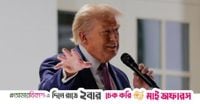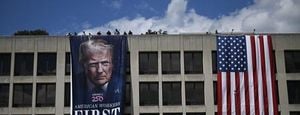On the world stage this September, tensions between the United States, China, and Russia have reached a fever pitch, as President Donald Trump signaled a possible escalation in economic pressure aimed at curbing Moscow’s war effort in Ukraine. The latest developments have placed China and India—major buyers of Russian oil—squarely in the crosshairs of a brewing tariff dispute, with Beijing delivering a sharp rebuke to Washington’s approach.
On September 10, 2025, according to reporting from AFP and other international outlets, Beijing publicly voiced its opposition to what it called “economic pressure” after President Trump floated the idea of steep tariffs—potentially between 50 and 100 percent—on countries purchasing Russian oil. This move, discussed during talks between US and European Union officials the previous day, was explicitly aimed at reducing the financial resources Russia uses to sustain its ongoing invasion of Ukraine.
“We firmly oppose the practice of constantly dragging China into the issue, and we firmly oppose the imposition of so-called economic pressure on China,” Chinese Foreign Ministry spokesperson Lin Jian stated at a regular press briefing, as cited by AFP. “China is neither the creator of this crisis nor a party to it.” Lin’s comments reflect a consistent line from Beijing throughout the Ukraine conflict: a claim of neutrality, regular calls for an end to hostilities, and an insistence that Western arms shipments to Ukraine only prolong the war.
The diplomatic friction comes at a sensitive moment in US-China relations, and the timing is no accident. Ahead of China’s massive military parade this month, Russian President Vladimir Putin told his Chinese counterpart Xi Jinping that the relationship between their countries was at an “unprecedented level.” This public show of solidarity between Moscow and Beijing is a clear signal to Washington and its allies that Russia is not as isolated as the West might hope.
The US, for its part, appears increasingly frustrated by the lack of progress in ending the war in Ukraine. President Trump, who took office in January predicting he could swiftly bring the conflict to a close, has found the reality far more complicated. According to Reuters, on September 8, 2025, Trump told reporters, “Yeah, I am,” when asked if he was ready to move to a second phase of sanctions against Russia. While his answer was terse and lacking in detail, it marked the closest he has come to openly endorsing a significant ramp-up in punitive measures targeting Russia or its oil customers.
Trump’s administration has already taken steps to squeeze Russia’s economy. On September 3, 2025, the president defended the imposition of punitive tariffs on India’s US-bound exports—a move he claimed cost Russia “hundreds of billions of dollars.” India, like China, is a major buyer of Russian energy, and Western buyers have sharply curtailed their purchases in response to the war. “You call that no action? And I haven’t done phase two yet or phase three,” Trump said, pointing to the possibility of even harsher measures in the near future.
Adding to the sense of urgency, US Treasury Secretary Scott Bessent said on September 8 that the US and European Union could consider “secondary tariffs on the countries that buy Russian oil,” a move designed to push the Russian economy “to the brink of collapse” and force President Putin to the negotiating table. “That cost hundreds of billions of dollars to Russia,” Bessent said, echoing Trump’s earlier remarks. The logic is straightforward: by targeting Russia’s remaining export markets, Washington hopes to cut off the lifeblood of Moscow’s war machine.
Yet, this strategy carries significant risks, especially in the delicate triangle between Washington, Beijing, and New Delhi. China, for one, has never condemned Russia’s invasion nor called for a withdrawal of troops. Instead, it has styled itself as a neutral party, even as it maintains robust trade ties with Moscow. Beijing has consistently accused Western countries of prolonging the conflict by providing arms to Ukraine, and it is now pushing back against what it sees as attempts to drag China into a war it did not start.
“China is neither the creator of this crisis nor a party to it,” Lin Jian reiterated at the press conference, underscoring Beijing’s resistance to being made collateral damage in what it views as a US-European effort to isolate Russia. The Chinese government’s stance is not just rhetorical; it reflects deep economic interests. As one of Russia’s largest energy customers, China has little incentive to see new tariffs drive up costs or disrupt supplies.
India, too, finds itself in a precarious position. While it has maintained friendly relations with both Washington and Moscow, New Delhi’s continued purchases of Russian oil have drawn increasing scrutiny from the West. Trump’s earlier move to slap punitive tariffs on Indian exports to the US was a signal that even longstanding partners are not immune from the widening sanctions net.
For the European Union, the prospect of joining the US in imposing secondary tariffs on Russian oil buyers is fraught with its own challenges. European countries have already slashed their imports of Russian energy, but the idea of targeting third countries like China and India raises the specter of a broader trade war, one that could disrupt global energy markets and further strain already tense diplomatic ties.
Meanwhile, the Kremlin is projecting confidence. In the run-up to China’s military parade, President Putin’s remarks to Xi Jinping about the “unprecedented level” of Russia-China relations were more than just diplomatic pleasantries. They were a message to the world that Moscow has powerful friends willing to stand by its side—even as the US and its allies seek to tighten the economic noose.
For now, Trump’s administration is walking a fine line between escalating pressure on Russia and avoiding a direct confrontation with China and India. The White House has not provided specifics on what the “second phase” of sanctions might entail, and officials have been careful to leave the door open for further negotiations. Still, the direction of travel is clear: Washington is prepared to use every tool at its disposal, including tariffs on third-party buyers, to try to end the war in Ukraine.
As the world watches, the stakes could hardly be higher. The coming weeks may determine not just the fate of Russia’s war effort, but the future of global trade relations between some of the world’s largest economies. One thing is certain: with rhetoric heating up and alliances hardening, the road to peace in Ukraine—and stability in the global economy—remains as uncertain as ever.




